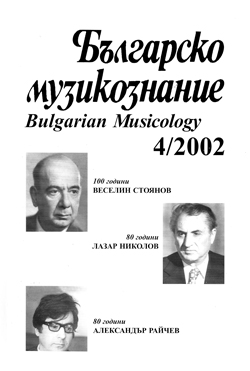Представи за Картаген в операта „Саламбо" от Веселин Стоянов и Борис Борозанов
Notions about Carthage in " Salambo"- Opera by Vesselin Stojanov and Boris Borosanoff
Author(s): Miglena TzenovaSubject(s): Music
Published by: Институт за изследване на изкуствата, Българска академия на науките
Summary/Abstract: Attempts for recovering the notions for Carthage by archeological explorations start officially in 1831 in Paris, more than 30 years (!) before creation of Flaubert’s novel “Salammbo”. Concluding from respectable coincidences of even small details in the novel with inquired historical records, Flaubert had been informed in length about the process of investigations, and probably about ancient historians’ notes. In this con nection, the opera com poser ‘s (and librettist’s) decision to stick rigidly to the literature work makes the opera historically reliable. The plot of the novel, and therefore of the opera is focused on the result of the so called First Punic War, led form 264 b. C. until 241 b. C. Carthaginians relate even their wartime exploits to all-powerful gods. Carthaginians’ religiousness takes a central place in the opera. Piety is a general part of the main characters, religious ceremonies of the community penetrate into the crowd scenes. Veneration of the Punic gods cruelty might be felt even in the Carthaginian enemies’ music cues. After the mid 40s of the XX th century religious aspect used to be muted and it stays beyond the musical critics’ attention - something that cannot change the nature of the work. The highest goddess - Tanit - combines features of a virgin and of a mother of many children. Among her “secret symbols” in the novel there are many musical instruments: different harps and lyres, tambourines, silver cymbals, holy d rums, flutes, etc. Salambo, the highest priests <l;nd priestess, priest-eunuchs and common people sing or whisper hymns to the goddess-mother under the accompaniment on musical instruments - mainly plucked stringed instruments, but also percussion and wood-wind instruments. The big orchestral stuff includes instruments as English corn, bass clarinet, glockenspiel, celesta, piccolo, tarn-tarn, triangle, cymbals, bass and small drum, tambourines and some other, which timbres (together with expanded strings and wood-winds) bring spirit of fairy-tale and whimsicality, and suggest an idea of archaism. Special role in the orchestral dramaturgy acts the timbre of the harp. Vesselin Stojanov’s brilliant orchestrating skills not only surround with ancient atmosphere of orientalism in Vesselin-Stojanov-style, but also come into the vocal parts. Also, this instrumental treatment envelops the episodes with a choir. Different social groups are presented by crowd choral scenes: mercenaries - in first scene; slaves of Carthage - in first scene, too; the priests - in second; fathers - in third and Carthaginian people - in third and sixth scene. Functions of the orchestra are very large and important - it comments, clears up, explains, emphasizes and grows quiet to listen attentively to the changes of action The cult unites the multinational Carthaginian community. And if we imagine Carthaginians as an entire organism and if we put religion at the place of its heart (I will remember here that the highest pries
Journal: Българско музикознание
- Issue Year: 2002
- Issue No: 4
- Page Range: 86-95
- Page Count: 10
- Content File-PDF

